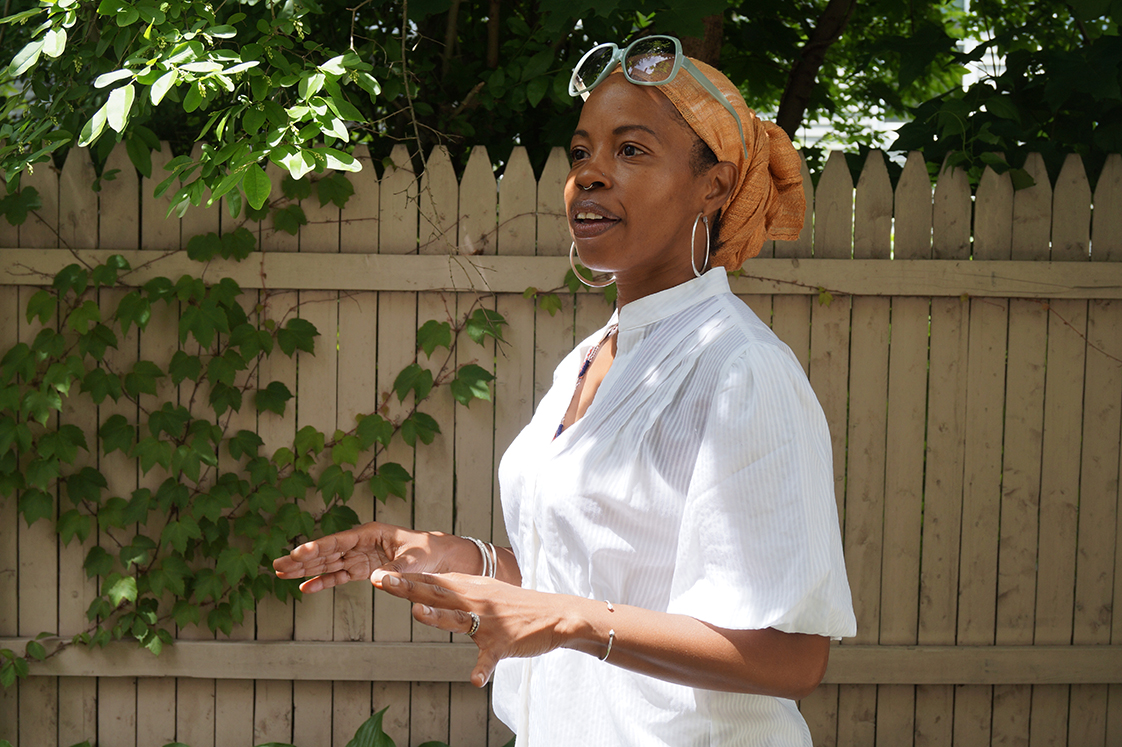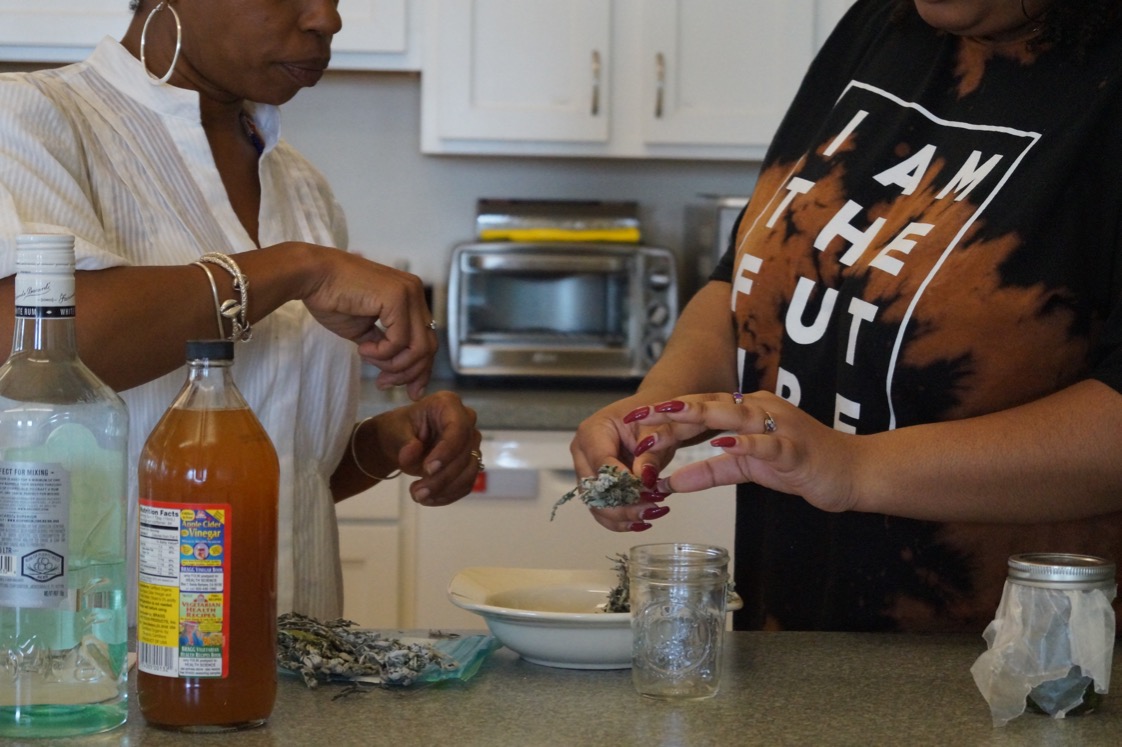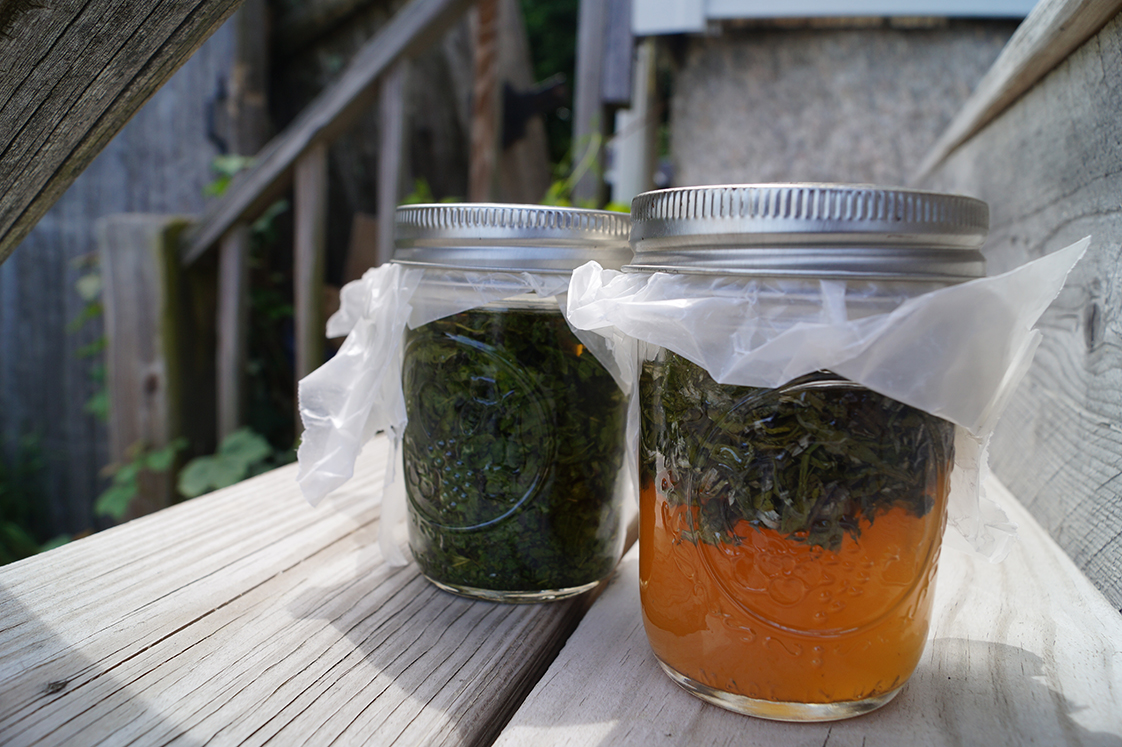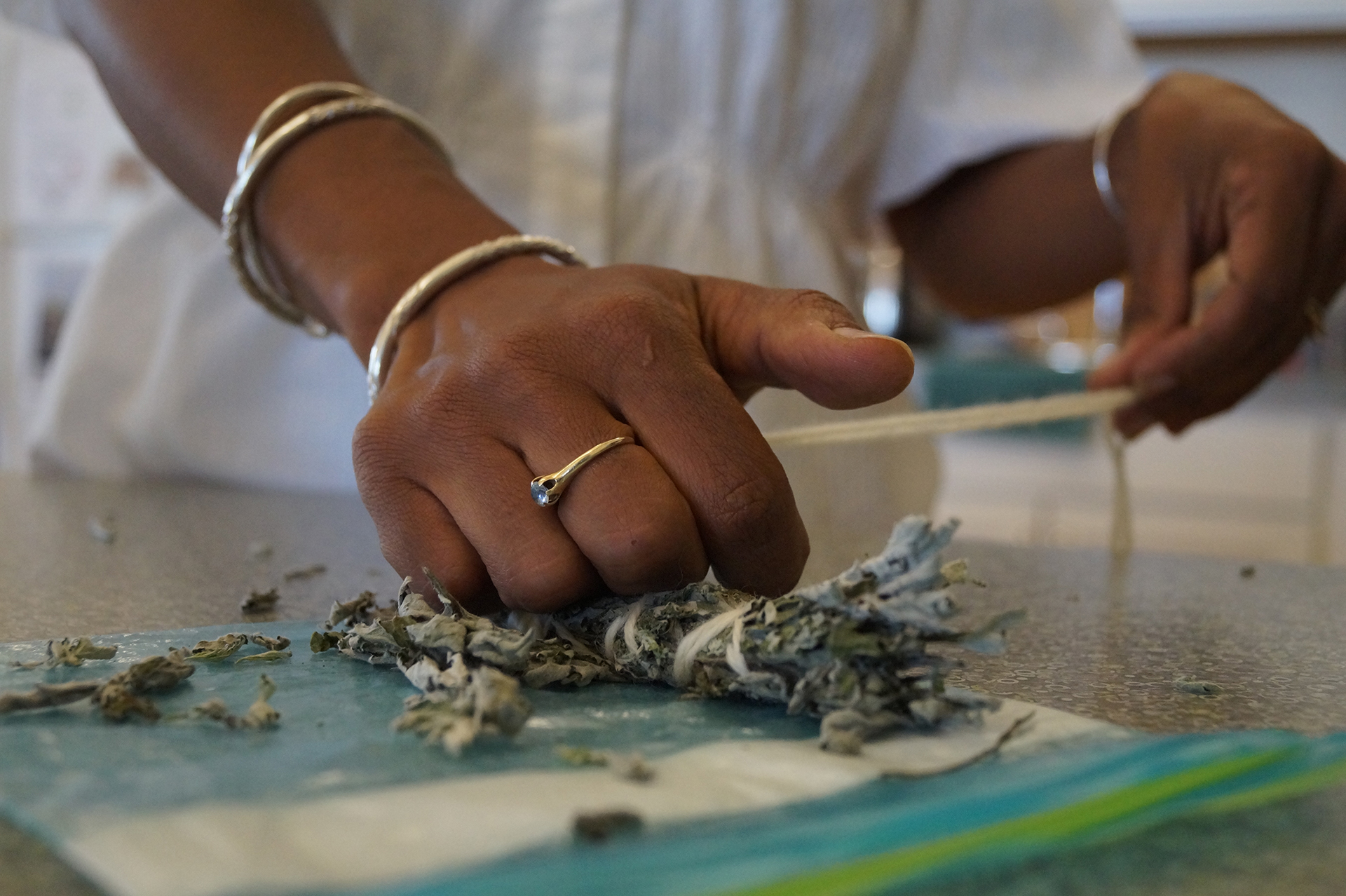I squint to avoid the sun’s brightness and inhale a familiar scent — the ocean. Ayo Ngozi, a Black herbalist, and I walk along Fort Phoenix Beach in search of beach roses. Today, she wears a white blouse, dark bootcut jeans, patterned sandals, and an orange head wrap. Before we reach the water, we wander into a natural archway created by trees on both sides of the path meeting in the middle. “Hi there,” Ngozi says as she walks off the path to pluck some violet flowers. We venture on, reaching the shore where we find white and pink roses in bloom. Ngozi speaks to the flowers as she searches for and pulls only the wilted petals of roses. Lucumí, the Cuban adaptation of traditional Yoruba spirituality and culture native to West Africa, informs her practice. She explains harvesting plants requires respect, and acknowledging them and not being greedy with how many she picks are part of that.
Ngozi is one of many herbalism educators who identify as a Black, Indigenous, and person of color (BIPOC) rising up to reclaim plant medicine and demand a voice in a space dominated by Eurocentric representations. This growing number of BIPOC works to enlighten communities on ancestral traditions that are often overlooked in popular culture. “I think now more and more of us are really starting to just connect with the medicine of our ancestors,” says Batul True Heart, a queer Native American, Panamanian, and Spanish herbalist from Oakland, Calif. Plant medicine has always been around, but modern herbalism is undergoing a visible transformation. “We are now entering the post-reconstruction era of herbalism. I feel like there have been more Black people speaking at white conferences as of late,” says Sade Musa, a Black herbalist from Los Angeles, Calif.
The reason BIPOC seek out plant medicine varies. Some see it as a way to carry on the traditions of their ancestors, while others would rather avoid the high costs of pharmaceutical medicine. For instance, 13.9% of adults aged 18 to 64 used alternative medicine as a strategy to reduce prescription drug prices, according to a 2017 study published in the Centers for Disease Control and Prevention’s National Center for Health Statistics 2019 data brief. Others would rather take their chances with alternative methods because they are concerned about the safety of pharmaceutical medicines. Meanwhile, a 2018 study on patients’ resistance to pharmaceuticalization in the United States found that racial minorities tend to be more skeptical of prescription drugs and their possible side effects compared to white people.
I primarily try to avoid modern medicine because of the costs and side effects, but I’m also motivated to pursue herbal medicine because of my experience as a Black American far removed from my African roots, a distance that leaves me eager to discover the lost practice of plant medicine. As BIPOC take an interest in teaching herbalism, people like me welcome the opportunity to learn and connect with ancestral practices through plants. Meeting with Ngozi serves as the first step on my journey to connect and revive plant knowledge related to the ancestral practices of my lineage.
Traveling to where Ngozi lives in New Bedford, Mass., I see many whales painted on buildings and featured in restaurant signage; even a whaling museum — all alluding to New Bedford’s whaling history. But I longed to connect with a different piece of this city’s past, one not as visible to a visitor — the city’s involvement in the abolitionist movement. I knew thousands of slaves fled from the South to the North, but I didn’t realize New Bedford had such a rich abolitionist history until speaking with Ngozi. She explains that most of the city took an anti-slavery stance. Free slaves and white people in the city worked together to protect escaped slaves which gave New Bedford its legacy that no slave was ever forcibly “reclaimed” from it. I scanned every inch of the city I drove past, trying to imagine the lives of those who passed through or settled in the city. I wondered if, by some unlikely chance, one of my ancestors sought refuge in New Bedford.
With the arrival of hundreds of escaped slaves also came traditions of Africa, and Ngozi’s efforts to honor and practice the herbal traditions of the African diaspora includes efforts to revive physical spaces important to that history. She currently heads up a project to replant and redesign the garden and landscape at the Nathan and Polly Johnson house. A national landmark, the house served as an underground railroad safe house for fugitive slaves, including Frederick Douglass. The plant life and landscape of the house reflect colonial times, but Ngozi and members of the Garden Committee of the New Bedford Historical Society are working to create an herb garden that’s a historically accurate representation of what Black people grew.
The house sits on a street known as “Abolition Row,” and as I walked on the sidewalk looking up at the massive white house with green shutters, I felt small under the weight of all the brave people who traveled this street in search of freedom. I stood in awe as I realized the privilege I had to freely stand where many runaway slaves had come as fugitives. Walking around the side of the house toward the backyard, I came upon what Ngozi referred to as a truck patch or dooryard garden. This is an herb garden traditionally located directly outside of the kitchen. Ngozi researched old cookbooks to identify the most relevant variety of plants to grow in the garden such as lemon balm, mint, yarro, lavender, chives, and borage. Some of the plants would have been used for cooking, while others are used strictly for medicinal purposes such as mullein, which was and still is used as an anti-inflammatory.

After returning to Groundwork, the coworking space she works out of, Ngozi walked me through a medicine-making lesson that incorporated my preferences and my dislikes. I’m not a fan of tea. So I used some dried herbs to make a folk lemon balm tincture and a mugwort tincture. But despite my preference for tinctures over teas, Ngozi wanted me to know an important truth: They’re not a prominent part of the herbal practices of the African diaspora for two reasons — it costs more to make tinctures, and slaves weren’t given alcohol, which is used to make them.
Essentially, a tincture is a concentrated liquid made from soaking herbs in alcohol or vinegar for weeks to extract the medicine, and a folk tincture simply means no measurements were used. To make it, I first crushed the lemon balm leaves in a bowl. The brittleness of the lemon balm made it easy to crush into little pieces. That process prompted the plant to release its strong citrusy aroma into my nose. I then placed the pieces into a mason jar and filled it with rum. Next, I crushed the mugwort. Much like the lemon balm, it was dry and brittle but felt soft like cotton. “Plants are like people,” Ngozi tells me. “They all have their own way of being.”
Earlier in the session, Ngozi explained this idea of spending time to get acquainted with a plant. As she spoke, questions began to pop inside my mind: Why would I do that? What would that even look like? But I silenced my internal questioning and focused on engaging all of my senses as Ngozi instructed. I focused on the petals, stems, the distinct smells, and the feel of the leaves as they brushed against my fingertips. It was then that I realized there is more to learn and know about a plant than I can see with my eyes or look up online. From then on, I experienced the plants with a newfound sense of respect and understanding. I completed the same steps with the mugwort as I did with the lemon balm — except this time, I filled the jar with apple cider vinegar. After four to six weeks, I can strain the plant, and the remaining liquid serves as the medicine. Although plants offer a variety of uses, Ngozi emphasized that the lemon balm is good for anxiety, and mugwort can help people enhance and remember dreams.

I tend to forget my dreams, but as Ngozi continued to speak about plants and their purposes, a memory of my grandmother began to form in my mind. At that moment, I heard the dry, brown earth crunch and snap underneath my feet as I ran around the backyard of my childhood home in San Diego. I knew if I fell, my body wouldn’t be caressed by soft, plush blades of grass. That knowledge failed to deter my desire to run and play. But on that day, a wrong step sent my right knee into the rough, prickly terrain. Tears filled my eyes. Bright red blood dripped down my leg from a wound opened by a thorn. I was five, but I knew what my grandma’s response would be as I headed into the house to show her — aloe vera leaf. Like many times before, she walked outside to her prized plants and used her hands to rip a piece off and a pair of scissors to cut into the flesh. The clear, slimy insides felt cold as she applied it to my knee, a feeling I could never quite get used to.
My grandma was a nurse, but she used natural remedies such as aloe vera for cuts and burns. She taught me that aloe vera gel helped to soothe and speed up the healing process. Eating raw garlic every day served as another staple of hers. She swore by its ability to treat a variety of medical conditions. I didn’t always see her eat it, but her breath told on her every time.
I personally teach to ignite a flame in people that will carry on this work.
The few herbal practices of my grandmother remain important to me. However, I never knew the reasons behind her teachings, and I’m not convinced she knew either. I don’t blame her. Historical tragedies led my family — and countless others who became defamiliarized with plant medicine thanks to a past that devalued, mocked, or erased our traditions and our history — to reach a point when the connection and explanations for folk medicine were no longer shared. As a result, we lost traditions or continued to others without knowing why.
The effects of colonization remain today. It robbed BIPOC of their traditions, cultural identity, land, and independence. Generations and generations later, millions of people still live disconnected from their ancestral roots. Calvis Williamson, a Black herbalist in Florida, says going into herbalism helped her reconnect with her ancestors. Her four-year journey as an herbalist led her to delve deeper into Southern herbalism practices such as reserving the pot liquor of collard greens to use in soups or stews. Pot liquor holds a lot of the beneficial nutrients that are removed from the greens when they cook, and it’s considered a tonic to some people. Using food as medicine is an important ancestral practice because slaves lacked access to allopathic medicine, Williamson says.
For many cultures, traditional folk medicine has gone unrecognized in mainstream culture. Up until the publishing of the Flexner report in 1910, which called for healthcare to follow the allopathic model of medicine, herbalism was a widely accepted form of medicine in the United States. In the early 19th century, people began to take an interest in alternative medicine. A self-taught herbalist and botanist named Samuel Thomson became an herbalist practitioner and developed what was once the main form of healthcare for most people in the United States, known as “Thomsonian medicine.” His methods, which embraced nature’s apothecary, lasted for decades and became one of the most well-known forms of alternative medicine during that time. Allopathy, by comparison, focuses on science-based medicine and gained support as herbalism fell out of favor. But mainstream herbalism returned in the ’60s and ’70s fueled by the “back to the land” movement, which was prompted by people’s desire to live a more self-sufficient and agrarian lifestyle. By the 1970s, there was a growing number of herbal books being published, along with the rise of herbalism classes and conferences offered. But this revival and Western herbalism historically left out the contributions of Black and brown peoples.

The lack of acknowledgment and credit for BIPOC in the herbalism space is a multifaceted issue that starts with insufficient access and appropriation. To start, colonization led many BIPOC to lose access to their land. In the 1800s, Native Americans underwent a massive removal from their ancestral lands in the Southeast, to lands west of the Mississippi River. With this move, they had to leave behind plants that were native to the Southeast such as saw palmetto, which served as a tonic. Today, saw palmetto supplements are now sold in stores like Walmart, GNC, and on Amazon. White sage is another popular herb held sacred to Native Americans which has been hijacked and commercialized. Native Americans have called out stores such as Sephora and Anthropologie for appropriating indigenous practices by selling sage and smudge kits. Generations of people have lost access to their own medicine, and then it’s packaged up and sold back to them, says Lara Pacheco, an herbalist of Puerto Rican and Taino lineage.
The same plant medicine being packaged and sold is the same medicine that some people used to survive off of and pass down through generations for free. Furthermore, the cost to learn the herbalism knowledge that was once a tradition is higher than many low-income people and people of color can afford. In 2017, schools that offered herbalism programs had an average tuition of about $17,000 and $20,000. “All of us are working with the same goal to increase access to medicine,” Musa says. BIPOC herbal medicine educators like Pacheco and many others are trying to remedy the high cost of education for people of color by offering scholarships and lowering cost options to their apprenticeship and immersion programs or workshops. For instance, Pacheco, the founder of Seed & Thistle Apothecary, has an apprenticeship program that regularly costs between $2,000 to $2,500; however, she offers full and partial scholarships for people who won’t be able to pay the minimum monthly cost of her programs, such as those who are out of work, in school full-time, under the age of 18, or have a disability.
While the costs of studying herbalism in America certainly haven’t hindered all BIPOC, the racial makeup of teachers is not representative of all the cultures that have contributed plant wisdom to Western herbalism. Teaching acts as a critical component of giving back the knowledge, but BIPOC are often not put in positions where they can spread information widely. There are major differences between Western and BIPOC herbalism that can’t be addressed if diverse people aren’t empowered to have a voice in this space.
I feel like working with herbal medicine is a really powerful way to reposition agency around the body, and I do feel like in Western society we’re taught that we need experts for just about everything.
Phelicia Magnusson, a queer herbalist of Sierra Leonean, Nigerian, and Norwegian descent from Seattle, Wash. has experienced firsthand how Western and BIPOC herbalism contrast each other. She’s equipped with the teachings of the ArborVitae School of Traditional Herbalism and elders in Costa Rica, Peru, and Hawaii. “I really felt like they were two different languages I was trying to speak,” Magnusson says. A major component of Indigenous herbalism that Western herbalism lacks is acknowledging the communication that happens between humans and the spirits of plants and land, Magnusson says. Similar to Ngozi and Magnusson, Heart is also familiar with talking to and having a relationship with plants. “If there’s someone I want to make a medicine for, when I’m going to harvest the plant, I’ll actually let that plant know about that person. I let that plant in on my prayer,” Heart says. “I ask them if they want to come and help. I wait and listen to their response.”
Practices such as this seem strange to me, but I recognize that colonization significantly diluted cultural traditions, causing them to become completely foreign over time. Classes being offered to BIPOC and taught by BIPOC are vital to the cultural revitalization because if ancestral insight isn’t being passed down, we risk losing it. “I personally teach to ignite a flame in people that will carry on this work,” Musa says.
Teaching herbalism that acknowledges the traditional practices of BIPOC is a significant part of reconnecting with ancestors, but it’s more than that. It’s a political statement. For Pacheco, herbalism is a form of social justice. She says she wanted to find a way to celebrate oppressed communities who have had their traditions looked down upon. The idea of decolonizing medicine plays heavily into the BIPOC herbalism community. Magnusson says she was drawn to herbalism out of a desire to have agency over her own body. “I feel like working with herbal medicine is a really powerful way to reposition agency around the body, and I do feel like in Western society, we’re taught that we need experts for just about everything,” Magnusson says.
As Ngozi gathered her things to leave, I stood shaking the jars, gazing into them as the bits of plants crashed against the top and bottom of the glass. As I watched the cascading herbs, I felt a strong sense that somewhere, my ancestors felt proud that I was beginning a journey to rewire my mind and to honor the plant medicine traditions they practiced. Doubt filled my mind about the concoction’s medicinal benefits. But I knew the jars held power, independence, and a connection to my ancestors. I carried the jars out knowing more shaking and waiting stood between me and being an official medicine maker. But for now, holding on to my people’s history was enough.

